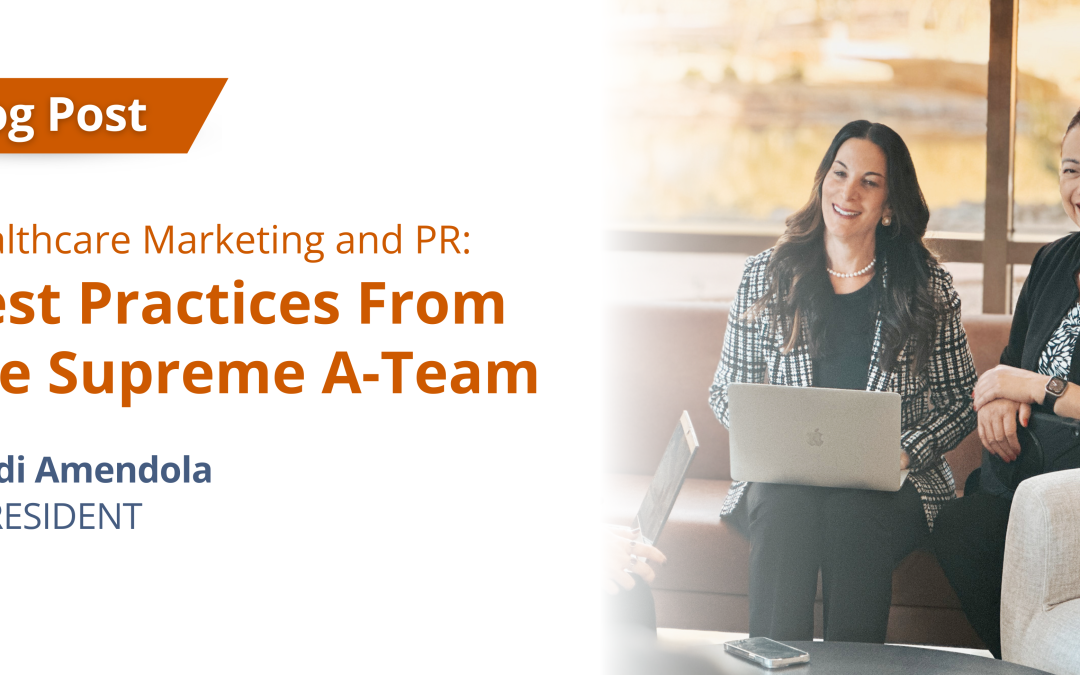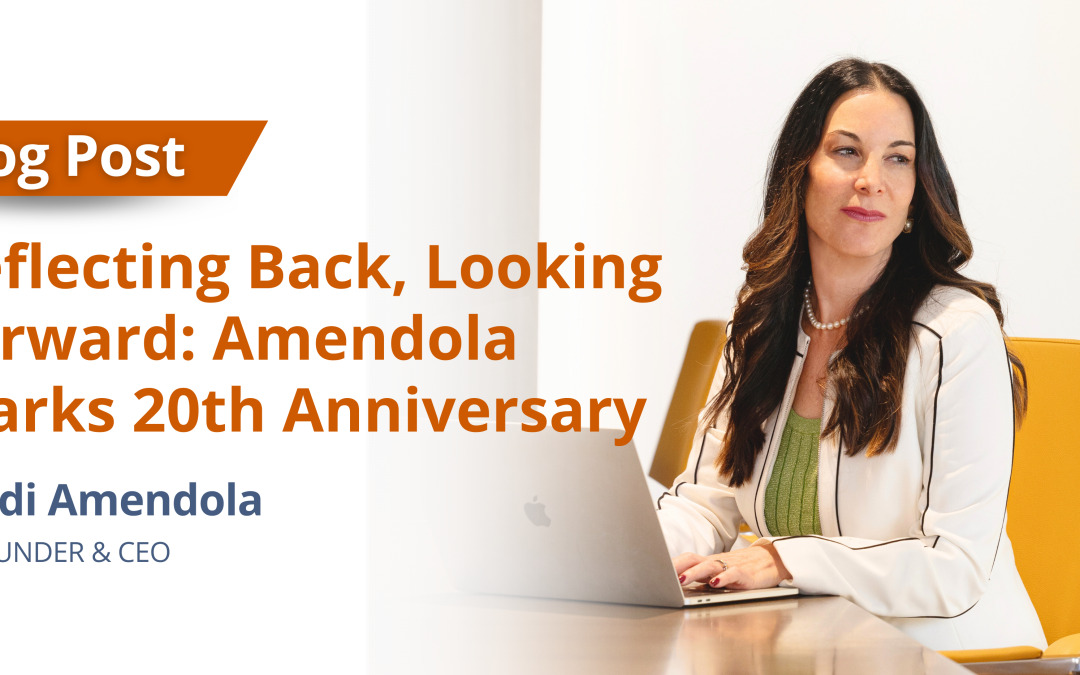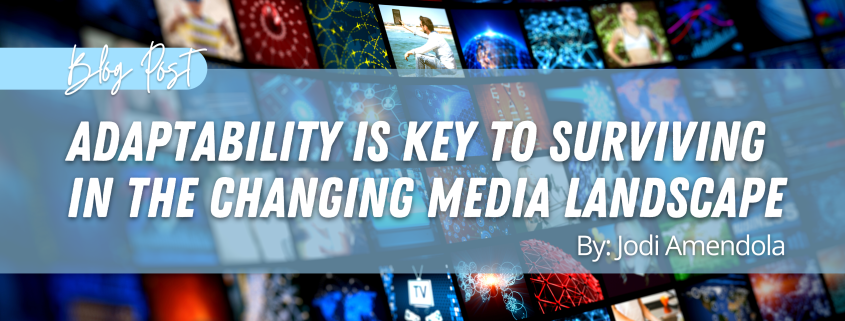
by Jodi Amendola | Jan 22, 2025 | Blog
One of the great pleasures of my job is watching members of the Amendola team – the A-Team – demonstrate their knowledge and expertise about public relations and marketing. I see this during staff meetings, on calls with clients and prospective clients, and in the work the A-Team produces for the many companies we represent. I go to sleep every night knowing I hired a team of senior level experts that truly shine.
Over the past year, A-Team members have offered their collective marketing and public relations wisdom through the Amendola blog. As I look back on 2024, I wanted to share with readers some of the blog posts that resonated most with me. Honestly, I could have made this list three times as long! I urge you to click on the links and check out some of the other Amendola posts. They are filled with actionable advice for healthcare technology companies seeking a competitive edge.
Spotting PR opportunities hiding in plain sight
Healthcare technology clients hire Amendola to help them raise their profiles in an exceedingly competitive business environment. And while many clients envision lavish write-ups in the Wall Street Journal or prominent healthcare media – something we’re all for, by the way! – coverage by smaller news outlets can be useful in building brand awareness among potential customers and investors.
“Though often overlooked, local news outlets can be valuable resources for public relations professionals and their clients,” our Senior Content Director Brandon Glenn notes in this blog post from January. “Whether they are general interest dailies, weeklies, or business publications, these media outlets are often interested in milestone topics that don’t necessarily appeal to trade or national media, such as hiring plans, headquarters’ expansions, acquisitions, and other factors that may affect the local economy.” See the opportunity, seize the opportunity.
Take the trade show by storm
Trade shows can cost healthcare technology companies a lot of money, especially if they have a booth on the show floor. It’s important, then, to get the most out of a trade show – otherwise you’re wasting time and funds that could be used elsewhere.
In addition to providing a forum for education and professional networking, trade shows can enable healthcare technology companies to build relationships with the media. In a February blog post, Account Director Kim Mohr offers some best practices for executives seeking to establish relationships with journalists from a variety of publications and mediums. These include preparing for scheduled interviews, being prompt (the journalist’s schedule will be crammed) and having a clear message (more on that later).
Fortune favors the bold – and creative
Amendola clients want to be noticed by investors and prospective customers. Yet they don’t want to stand out for the wrong things. As a result, many of them fear that expressing a strong opinion or point of view will distract from their message and cost them business.
But as Account Director and Media Specialist Grace Vinton warns in this May blog post, “Healthcare technology companies that hide in the herd and play it safe get ignored.” A far more effective strategy, Grace writes, is to “inject your marketing and PR initiatives with a strong storyline framework that employs passion, humanity, humor, and a distinctive voice.” This can be done through social media, bylines, podcasts, and (as discussed above) speaking at conferences. Humanity sells because we’re all human.
Simple sentences, clear messaging
To build brand awareness and grow revenue, healthcare technology companies need clear, concise messaging. That can be difficult when you’re in the business of applying advanced technologies to complex healthcare challenges.
Still, language that is “direct, straightforward and, above all, clear and free of unnecessary jargon” will pay off in the long run. In an August blog post, Amendola Senior Account and Content Director Jim Sweeney explains, “Keeping it simple means your message will be better understood and your busy readers will be grateful for not having to decipher your writing.” Couldn’t have said it better (or simpler) myself.
Compelling lead magnets
Strong customer leads are the refined fuel of the sales pipeline. Healthcare technology companies can use lead magnets to capture and nurture promising leads by offering value in exchange for their contact details.
The best lead magnets are tailored to your target audience’s needs, deliver the value promised, are easy to consume, and can be readily shared, according to Senior Account Director Janet Mordecai. But that’s just a partial list; read about more characteristics of winning lead magnets in Janet’s October blog post.
Conclusion
2024 was an amazing year. In fact, we are bigger and better now as we are part of the Supreme Group. My crystal ball tells me that 2025 will be even better. The A-Team and I can’t wait to continue working with clients whose technologies will help transform healthcare to save and improve lives. We’re in this together.

by Jodi Amendola | Jun 26, 2024 | Blog
As I look back at two decades of running a successful PR and marketing agency, I can draw two conclusions: Predicting the future is impossible, but preparing for it is a necessity.
That’s not the contradiction it first appears to be. Twenty years ago, it was the dawn of the digital age for healthcare and I was certain there would be an opportunity for an agency devoted to healthcare, health tech and life sciences. I didn’t know with any degree of precision what was coming, but I knew I wanted to be a part of it.
So, I took the leap and founded Amendola. My crystal ball was clear enough to spot an emerging opportunity, but it could not have anticipated everything that would happen in healthcare and health tech over the next two decades: generative AI, machine learning, genetic and precision medicine, telehealth, the shift to value-based care, remote patient monitoring and more.
In all, it’s fair to say the last 20 years have been some of the most exciting and transformative in the history of healthcare. My agency has not only weathered these tumultuous times, but prospered in them.
Amendola is the recognized industry leader in promoting visionary organizations driving technological change across healthcare delivery and life sciences. We have earned billions of media impressions for clients and received numerous awards from industry organizations honoring the firm’s innovative content generation, media relations and marketing programs.
Our success is not due to anticipating every development, but to being prepared for them.
I built the agency around the principles that I value in PR and marketing: creativity, continuous learning, collaboration, and a deep commitment to customer service and delivering results. With those as our bedrock we have been able to meet each new challenge and help our clients find their footing in the new digital landscape.
From early-stage startups to publicly traded companies, Amendola has helped drive company recognition, revenue growth and wider implementation of cutting-edge IT solutions across healthcare delivery organizations, health insurers, pharmacies and numerous other entities. Amendola has also helped clients pivot their messaging and content during changes in healthcare, such as during the COVID-19 pandemic when care delivery began a greater shift from brick-and-mortar institutions to patients’ homes through telehealth and virtual care.
I want to thank the many clients who have hired Amendola multiple times, bringing us with them as they have moved from company to company. Many of them have become friends over the years, which has been an unexpected bonus.
Of course, most of the credit for our success goes to my team. I make a point of hiring only experienced professionals with deep backgrounds in healthcare, health tech and life sciences. They share my principles, are committed to evolving as healthcare does, and their fine work and dedication have allowed the agency to grow and prosper.
A 20th anniversary is a chance not only to reminisce, but to look ahead. And my crystal ball is no more finely tuned than it was when I founded the agency. I don’t know exactly what will happen over the next decade or two; no one does. I will stand by two predictions, however: The years ahead will be at least as exciting and unpredictable as the past 20.

by Jodi Amendola | Apr 3, 2024 | Blog
If you’re a content creator, it’s essential to also be a heavy consumer of content.
To write authoritatively and informatively, you need to stay current with what thought leaders, influencers, and industry experts are talking about, and that means consuming content – whether in the form of news articles, industry journals, social media, videos, or whatever channel you prefer.
As an avid content consumer, one of the most common, easily correctable mistakes I see is known as “burying the lede.” (The term began being spelled as “lede” at mid-20th century newspapers to avoid confusion with references to the printing press, which was made of “lead” metal. It doesn’t seem all that complicated to me, and it makes you wonder how often the two terms were used interchangeably that it really became that much of a problem, but we’ll move on.)
Stated succinctly, the “lede” is the most important, newsworthy part of the story. It answers two critical questions that every reader asks themselves, whether consciously or subconsciously, when beginning to engage with any piece of content: What is this about, and why should I care?
When writers bury the lede, they test their readers’ patience and increase the likelihood that readers will bail out before reaching the end.
The MLA Style Center offers this example of a buried lede: Say that two people died in a house fire, but the article mentions the location, time, or cause of the fire prior to the occurrence of the deaths.
The lesson is just as applicable to health IT thought leadership as it is to basic journalism. Maybe you believe Medicare Advantage needs to be expanded because it offers seniors a low-cost way to access non-traditional medical benefits that can improve health outcomes. Alternatively, maybe you think Medicare Advantage is a government-sponsored corporate giveaway that large insurers have exploited to fraudulently inflate their profits by billions.
Either position is defensible. Simply stake your position out, concisely explain why you feel that way, and do it while you’ve still got the reader’s attention.
In other words, say it clearly, and say it early. (This is also known in writing circles as the “nut graf” and if you’re sensing an unfortunate trend in these naming conventions, you’re not alone.)
“Burying the lede” isn’t a topic that lends itself to the blog or listicle format of “X Helpful Tips.” Just be aware that the problem is real and rampant, remain conscious of it, and don’t do it.
Simply answer the two magic clarifying questions – “What is this article talking about and why should anyone care?” – at or near the top of anything you write, and the problem is solved.

by Jodi Amendola | Jan 18, 2024 | Blog
Many of the challenges that healthcare organizations faced in 2023 – inflation, labor shortages, worker burnout, and narrow margins – are likely to persist in 2024.
These factors are certain to make for a challenging operating environment, and most healthcare executives are taking a clear-eyed, creative look at how to overcome these looming barriers over the next year—including the use of novel health tech and medtech.
Only 3% of health system executives and 7% of health plan executives report having a “positive” outlook for 2024, according to Deloitte’s annual “Health Care Outlook Survey.” Those numbers are down substantially from the prior year, when 15% of health system executives and 40% of health plan leaders reported positive outlooks.
Nonetheless, healthcare organizations will no doubt continue to invest in new technology solutions to surmount many of the operating obstacles that are confronting them. But which technologies are likely to deliver the biggest impact in healthcare in the next year? I wanted to hear from the experts, so I polled a number of my contacts in the healthcare analyst community. Below are their predictions.
- Jennifer Eaton, RN, MSN, CCDS, CRCR, research director, value-based healthcare digital strategies with IDC, notes that key industry players will continue to invest in digital solutions that support operational efficiency, optimized value, cost containment, and patient-centric care.
“This year will usher in an evolution in value-based care initiatives (i.e., reducing health disparities, accurate predictive analytics, AI-supported workflows, and hyper-personalized engagement strategies) that are especially appealing as payers and providers aim to strike a balance between the cost and quality of care,” she said. “As healthcare organizations continue to face a variety of challenges such as inflationary pressures, labor and skills shortages, clinician burnout, and evolving consumer expectations, organizations are focusing on digital transformation and digital infrastructure creation that supports automation, deeper intelligence, and real-time insights that can minimize the drudgery and low-value work that has plagued the healthcare industry and shift this valuable time and attention to the patient.”
- While much of the industry’s focus in 2023 was on the challenging operating climate for hospitals and health systems, payers will face similar obstacles next year, according to Jeff Rivkin, research director, payer IT strategies, IDC.
“Payers face payer-provider convergence, care delivery modernization, digital business expectations, and adopting a unified healthcare experience in 2024, on top of mandates around price transparency and prior authorizations,” Rivkin said. “It’s hard to make money only being a health insurance company, so creative innovations and business models will thrive to address cost-of-care, labor shortages, and legacy technical debt.”
- Since the emergence of Chat GPT, generative artificial intelligence (AI) has been among the hottest topics in health IT, as well as executive suites across nearly all industries. As generative AI models mature, healthcare organizations will increasingly look to implement them, according to Delfina Huergo Bensadon, senior research and consulting analyst, Frost & Sullivan.
“One of the digital health trends we are seeing at Frost for 2024 is the increasing adoption of generative AI in healthcare organizations, as the physician’s main concern of accountability is addressed globally through regulations, such as the AI Act,” she said.
- Elena Iakovleva, research analyst, Chilmark Research, foresees increasing investment in AI-based technologies to improve both patient care and healthcare administration.
“Remote Patient Monitoring (RPM) solutions will definitely be on the rise,” she said. “Often the accuracy of existing monitors isn’t that good (Hi, Apple Watch and friends) and without a doubt in 2024, major RPM vendors will be competing for the best data available to train their models.”
Additionally, AI will continue to transform providers’ approach to revenue cycle management (RCM), according to Iakovleva. “We have been observing tremendous growth of various RCM-oriented AI technologies,” she said. “In 2023 it feels like we hit a critical mass and by the end of 2024 we should start seeing a big change in RCM departments across the U.S. and professions associated with RCM.”
- John Moore III, managing partner, Chilmark Research, foresees increased emphasis on the importance of healthcare organizations addressing patients’ social determinants of health needs.
“We will see the first ‘backbone’ organizations funded by federal grants connecting with care organizations to create closed-loop referrals to community-based organizations,” Moore said. “Safety-net and capitated hospitals already piloting ‘food pharmacy’ and other healthcare-related social needs initiatives will receive federal funding for these programs via new community-benefit designations.”
Of course, we already know what the biggest news story of 2024 is bound to be – the presidential election – and healthcare, as usual, is sure to play a role.
“With the 2024 election looming, both parties will step up pressure around reigning in healthcare costs and system abuses to win points with the electorate,” Moore said.

by Jodi Amendola | Nov 30, 2022 | Blog
Blink and the media landscape changes: a magazine goes out of business, one company acquires another, a podcast launches.
Blink again and something else has changed.
In the nearly 20 years since I founded Amendola Communications, the media landscape for healthcare and healthcare technology has changed dramatically. Publications that I assumed would last forever are long gone while others have sprouted in their place. The dominant medium has shifted from print to digital and the lead time for news has shrunk from days and weeks to, well, almost nothing.
The number of journalists covering healthcare is also greatly reduced. The big publications once had mastheads with multiple editors and reporters; now, most have only a few and they’re juggling podcasting and social media duties along with reporting and writing.
I hate to see any media outlet vanish. That’s partly for selfish reasons; fewer outlets means fewer places we can pitch. But it’s also because I love journalism and I love helping clients get their news out.
But nostalgia is an indulgence, not a business model.
That’s why, amidst all the change, Amendola Communications remains focused on the constants: the need for companies to spread the word about their products and services and the interest in them among the industry. While there might be fewer media outlets now, there is more healthcare news and content than ever before and it’s just as important to get it seen.
So we’ve adapted our approach. Rather than primarily pitching media interviews, we now do a lot more content development where we conceive a story idea, pitch it to a media outlet, and then have one of our writers create a draft that is vendor-neutral and publishable.
Another example of adaptability is how we’ve had to change our approach to media interviews at key trade shows, such as HIMSS, HLTH and others. Instead of only relying on in-person interviews at the shows, we have been super-aggressive in securing more podcast and video interview opportunities for our clients as well as focusing on pre-and-post show news coverage.
We also now operate in a world where clients are less dependent on third-party outlets. Companies have acquired the ability to speak directly to customers through their own blogs, emails, websites, social media, webinars, podcasts and, in some cases, publications. Indeed, consumers now expect a more direct link with and greater insight into the companies they work with and those businesses can no longer depend on third-party media to provide that.
This good news is that this allows businesses to be more creative, comprehensive and in control of how their images are presented and how their stories are told. A big part of what we do now at Amendola is creating content for our customers and advising them on the best format for that information.
In an ever-changing environment, the greatest necessity for ourselves and our clients is adaptability in how we craft and deliver our messages.
Page 1 of 712345...»Last »




